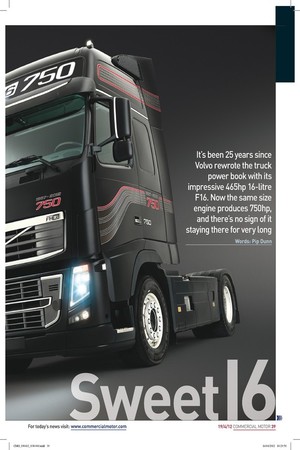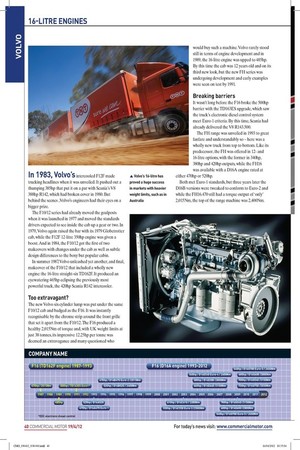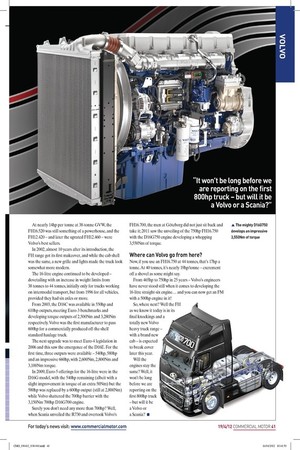VOLVO
Page 30

Page 31

Page 32

Page 33

If you've noticed an error in this article please click here to report it so we can fix it.
16-LITRE
ENGINES
25 years of Volvo’s legendary 16-litre engines
It’s been 25 years since Volvo rewrote the truck power book with its impressive 465hp 16-litre F16. Now the same size engine produces 750hp, and there’s no sign of it staying there for very long
Words: Pip Dunn In 1983, Volvo’s intercooled F12F made trucking headlines when it was unveiled. It pushed out a thumping 385hp that put it on a par with Scania’s V8 388hp R142, which had broken cover in 1980. But behind the scenes ,Volvo’s engineers had their eyes on a bigger prize.
The F10/12 series had already moved the goalposts when it was launched in 1977 and moved the standards drivers expected to see inside the cab up a gear or two. In 1979, Volvo again raised the bar with its 1979 Globetrotter cab, while the F12F 12-litre 350hp engine was given a boost. And in 1984, the F10/12 got the first of two makeovers with changes under the cab as well as subtle design differences to the boxy but popular cabin.
In summer 1987, Volvo unleashed yet another, and final, makeover of the F10/12 that included a wholly new engine: the 16-litre straight-six TD162F. It produced an eyewatering 465hp eclipsing the previously most powerful truck, the 420hp Scania R142 intercooler.
Too extravagant?
The new Volvo six-cylinder lump was put under the same F10/12 cab and badged as the F16. It was instantly recognisable by the chrome strip around the front grille that set it apart from the F10/12. The F16 produced a healthy 2,015Nm of torque and, with UK weight limits at just 38 tonnes, its impressive 12.25hp per tonne was deemed an extravagance and many questioned who would buy such a machine. Volvo rarely stood still in terms of engine development and in 1989, the 16-litre engine was upped to 485hp. By this time the cab was 12 years old and on its third new look, but the new FH series was undergoing development and early examples were seen on test by 1991.
Breaking barriers
It wasn’t long before the F16 broke the 500hp barrier with the TD163ES upgrade, which saw the truck’s electronic diesel control system meet Euro-1 criteria. By this time, Scania had already delivered the V8 R143.500.
The FH range was unveiled in 1993 to great fanfare and understandably so – here was a wholly new truck from top to bottom. Like its predecessor, the FH was offered in 12and 16-litre options, with the former in 340hp, 380hp and 420hp outputs, while the FH16 was available with a D16A engine rated at either 470hp or 520hp.
Both met Euro-1 standards, but three years later the D16B versions were tweaked to conform to Euro-2 and while the FH16.470 still had a torque output of ‘only’ 2,015Nm, the top of the range machine was 2,400Nm.
At nearly 14hp per tonne at 38-tonne GVW, the FH16.520 was still something of a powerhouse, and the FH12.420 – and later the uprated FH12.460 – were Volvo’s best sellers.
In 2002, almost 10 years after its introduction, the FH range got its first makeover, and while the cab shell was the same, a new grille and lights made the truck look somewhat more modern.
The 16-litre engine continued to be developed – dovetailing with an increase in weight limits from 38 tonnes to 44 tonnes, initially only for trucks working on intermodal transport, but from 1996 for all vehicles, provided they had six axles or more.
From 2003, the D16C was available in 550hp and 610hp outputs, meeting Euro-3 benchmarks and developing torque outputs of 2,500Nm and 3,280Nm respectively. Volvo was the first manufacturer to pass 600hp for a commercially produced off-the-shelf standard haulage truck.
The next upgrade was to meet Euro-4 legislation in 2006 and this saw the emergence of the D16E. For the first time, three outputs were available – 540hp, 580hp and an impressive 660hp, with 2,600Nm, 2,800Nm and 3,100Nm torque.
In 2009, Euro-5 offerings for the 16-litre were in the D16G model, with the 540hp remaining (albeit with a slight improvement in torque of an extra 50Nm) but the 580hp was replaced by a 600hp output (still at 2,800Nm) while Volvo shattered the 700hp barrier with the 3,150Nm 700hp D16G700 engine.
Surely you don’t need any more than 700hp? Well, when Scania unveiled the R730 and overtook Volvo’s FH16.700, the men at Göteborg did not just sit back and take it; 2011 saw the unveiling of the 750hp FH16.750 with the D16G750 engine developing a whopping 3,550Nm of torque.
Where can Volvo go from here?
Now, if you use an FH16.750 at 44 tonnes, that’s 17hp a tonne. At 40 tonnes, it’s nearly 19hp/tonne – excrement off a shovel as some might say.
From 465hp to 750hp in 25 years – Volvo’s engineers have never stood still when it comes to developing the 16-litre straight-six engine... and you can now get an FM with a 500hp engine in it!
So, where next? Well the FH as we know it today is in its final knockings and a totally new Volvo heavy truck range – with a brand new cab – is expected to break cover later this year.
Will the engines stay the same? Well, it won’t be long before we are reporting on the first 800hp truck – but will it be a Volvo or a Scania? n











































